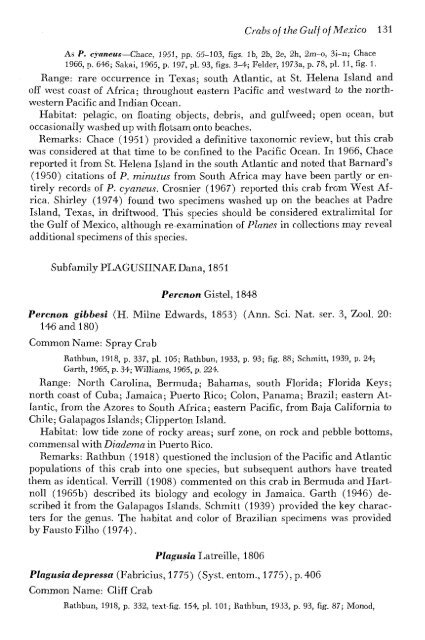You also want an ePaper? Increase the reach of your titles
YUMPU automatically turns print PDFs into web optimized ePapers that Google loves.
Crabs of the Gulf of Mexico 131<br />
As P. cyaneus—Chace, 1951, pp. G5-103, figs, lb, 2b, 2e, 2h, 2in-o, 3i-ii; Chace<br />
1966, p. 646; Sakai, 1965, p. 197, pi. 93, figs. 3-4; Felder, 1973a, p. 78, pi. 11, fig. 1.<br />
Range: rare occurrence in Texas; south Atlantic, at St. Helena Island and<br />
off west coast of Africa; throughout eastern Pacific and westward to the northwestern<br />
Pacific and Indian Ocean.<br />
Habitat: pelagic, on floating objects, debris, and gulfweed; open ocean, but<br />
occasionally washed up with flotsam onto beaches.<br />
Remarks: Chace (1951) provided a definitive taxonomic review, but this crab<br />
was considered at that time to be confined to the Pacific Ocean. In 1966, Chace<br />
reported it from St. Helena Island in the south Atlantic and noted that Barnard's<br />
(1950) citations of P. minuius from South Africa may have been partly or entirely<br />
records of P. cyaneus. Crosnier (1967) reported this crab from West Africa.<br />
Shirley (1974) found two specimens washed up on the beaches at Padre<br />
Island, Texas, in driftwood. This species should be considered extralimital for<br />
the Gulf of Mexico, although re-examination of Planes in collections may reveal<br />
additional specimens of this species.<br />
Subfamily PLAGUSIINAE Dana, 1851<br />
Percnon Gistel, 1848<br />
Percnon gibbesi (H. Milne Edwards, 1853) (Ann. Sci. Nat. ser. 3, Zool. 20:<br />
146 and 180)<br />
Common Name: Spray Crab<br />
Rathbun, 1918, p. 337, pi. 105; Rathbun, 1933, p. 93; fig. 88; Schmitt, 1939, p. 24;<br />
Garth, 1965, p. 34; Williams, 1965, p. 224.<br />
Range: North Carolina, Bermuda; Bahamas, south Florida; Florida Keys;<br />
north coast of Cuba.; Jamaica; Puerto Rico; Colon, Panama; Brazil; eastern Atlantic,<br />
from the Azores to South Africa; eastern Pacific, from Baja California to<br />
Chile; Galapagos Islands; Clipperton Island.<br />
Habitat: low tide zone of rocky areas; surf zone, on rock and pebble bottoms,<br />
commensal with Diadema in Puerto Rico.<br />
Remarks: Rathbun (1918) questioned the inclusion of the Pacific and Atlantic<br />
populations of this crab into one species, but subsequent authors have treated<br />
them as identical. Verrill (1908) commented on this crab in Bermuda and Hartnoil<br />
(1965b) described its biology and ecology in Jamaica. Garth (1946) described<br />
it from the Galapagos Islands. Schmitt (1939) provided the key characters<br />
for the genus. The habitat and color of Brazilian specimens was provided<br />
byFaustoFilho (1974).<br />
PZagMsia La treille, 1806<br />
Plagusiadepressa (Fabricius, 1775) (Syst. entom., 1775), p. 406<br />
Common Name: Cliff Crab<br />
Rathbun, 1918, p. 332, text-fig. 154, pi. 101; Rathbun, 1933, p. 93, fig. 87; Monod,

















